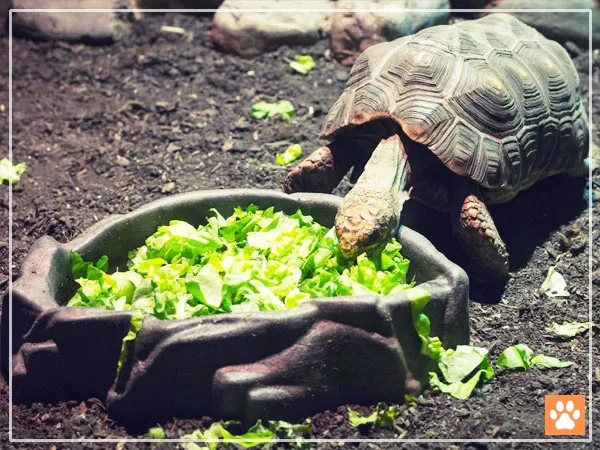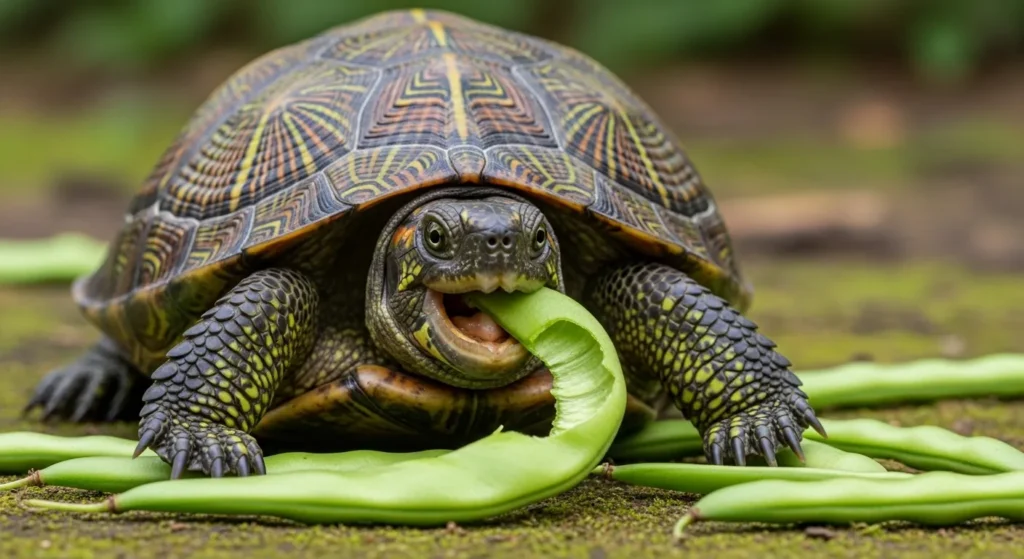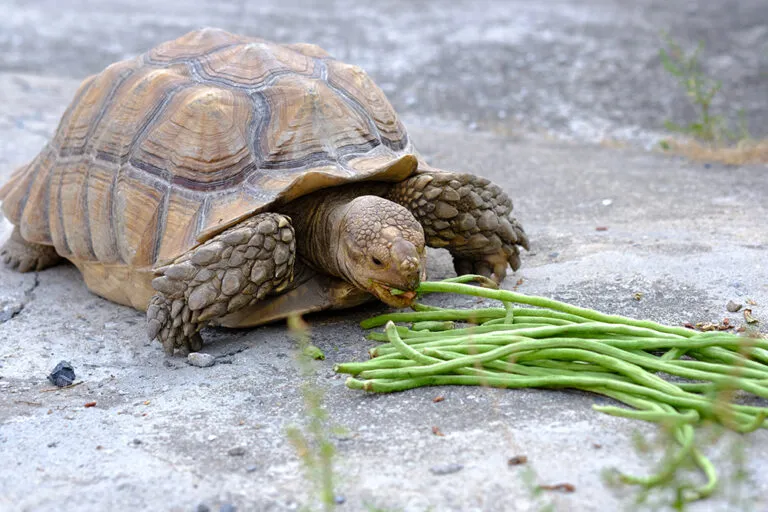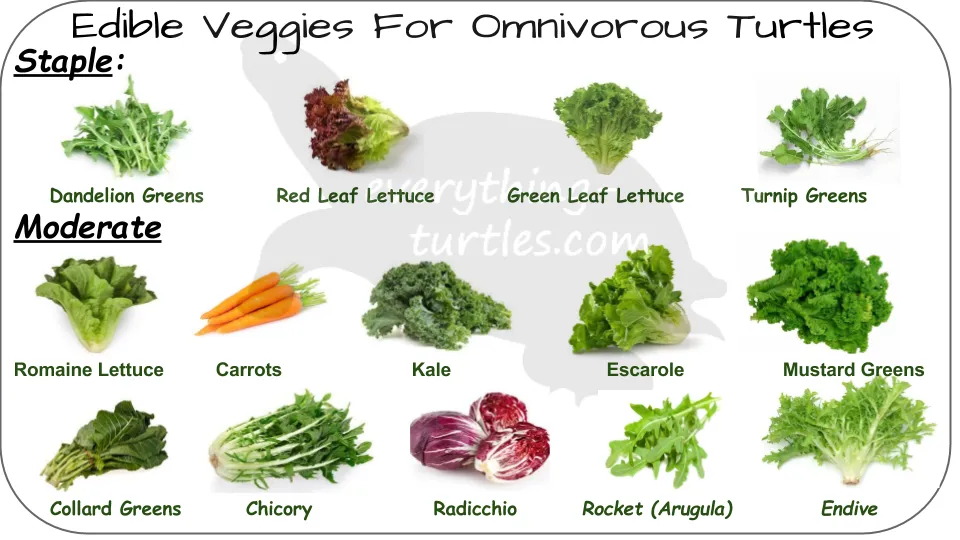
Turtles need a healthy and safe diet to live long, and every owner wants to know which foods are good for them. One common question is whether green beans are safe for turtles. The answer is yes, turtles can eat green beans, and they can benefit from the vitamins and fiber inside them.
These nutrients support growth, digestion, and overall health. Still, green beans should not be the only food, because turtles need a mix of vegetables, proteins, and calcium for balance. By learning the right way to add green beans to their meals, you can keep your turtle healthy, active, and safe.
What Do Turtles Normally Eat in Their Daily Diet?
Turtles eat both plants and small animal foods. In daily life, they like leafy greens, vegetables, and sometimes a little fruit. They also need protein from insects, worms, or small fish to stay strong. Calcium is very important because it keeps their shell hard and healthy. A mix of vegetables, protein, and calcium makes a turtle’s diet safe and balanced.
Can Turtles Eat Green Beans Safely?

Yes, turtles can eat green beans safely, but they should be given in small amounts. Green beans have vitamins, fiber, and minerals that help turtles stay healthy and active. They are safe to eat, but turtles should not eat only green beans because they need a mixed diet of vegetables, protein, and calcium for balance. When fed in the right way, green beans can be a safe and healthy part of a turtle’s meal.
Why Green Beans Can Be Healthy for Turtles
Before adding any food to your turtle’s diet, it’s important to know how it helps their body. Green beans are not just a filler snack, they bring real nutrition that can support your turtle’s health in many ways.
- Green beans have vitamins A, C, and K which support turtle growth and immunity.
- They provide fiber that helps with smooth digestion and keeps the stomach healthy.
- Green beans contain minerals like iron and magnesium that give turtles strength and energy.
- They are low in fat and calories, making them a light and safe food choice.
- The water content in green beans helps keep turtles hydrated and active.
- When added with other foods, they make the diet balanced and more nutritious.
Risks of Feeding Too Many Green Beans to Turtles
Green beans are safe for turtles, but too much of anything can create health problems. Knowing the risks helps you keep your turtle’s diet balanced and safe.
- Too many green beans can cause stomach upset or loose stool in turtles.
- They may make the diet unbalanced if turtles eat them instead of other healthy foods.
- Overfeeding can reduce intake of calcium-rich foods, which are important for shell strength.
- Relying only on green beans can lead to slow growth and weak immunity.
- Turtles may lose interest in other nutritious vegetables and proteins if beans are given too often.
How to Feed Green Beans to Your Turtle
Feeding green beans to turtles is not just about giving them a snack — it’s about preparing the food in a way that keeps them safe and healthy. Here’s a simple step-by-step guide:
1 Wash the beans carefully
Always rinse green beans under clean water. This helps remove dirt, dust, or pesticide chemicals that could harm your turtle’s health.
2 Cut into small pieces
Turtles have small mouths and cannot chew large chunks. Small bite-sized cuts make eating easier and prevent choking.
3 Serve raw or lightly steamed
Raw beans give more fiber, while lightly steamed beans become softer and easy to digest. Avoid adding salt, oil, or spices because turtles cannot handle seasonings like humans.
4 Offer in small portions
Green beans should only be a part of the diet, not the main food. Mixing them with leafy greens, pellets, or fruits gives your turtle a balanced and healthy meal.
5 Remove leftovers quickly
Uneaten beans can rot in water tanks and create bacteria. Cleaning up after feeding keeps your turtle’s home fresh and safe.
How Much Green Beans Should Turtles Eat?

Green beans are safe for turtles, but they should only be given in small amounts as part of a balanced diet. The best portion size is usually equal to the size of your turtle’s head, which is a simple rule many experts suggest for safe feeding. Green beans should not make up more than 10–15% of their total diet, because turtles also need leafy greens, pellets, and other vegetables for complete nutrition.
Offering green beans two to three times a week is enough, and giving more than that may cause digestive imbalance. Baby turtles should get very small, finely cut pieces, while adult turtles can have slightly larger bites, but the serving size should always stay limited. If your turtle often leaves food uneaten, it means the portion is too big, and if it eats too fast, you can mix beans with other vegetables to balance the meal.
Raw vs Cooked Green Beans – Which Is Better for Turtles?
| Aspect | Raw Green Beans | Cooked Green Beans |
| Nutrient Value | Keeps all vitamins, minerals, and fiber in natural form | Some vitamins (like Vitamin C) may reduce during cooking |
| Digestibility | A bit harder to chew and digest, especially for young turtles | Softer texture makes it easier to chew and digest |
| Water Content | Naturally high, helps in hydration | Still has water but slightly reduced after cooking |
| Taste & Texture | Crunchy and fresh, encourages natural chewing | Soft and mild, easier for picky eaters |
| Safety | Safe if washed properly, avoid pesticides | Safe if boiled/steamed without oil, salt, or spices |
| Best Use | Good for adult turtles with strong jaws | Good for young, old, or weak turtles who need softer food |
Different Ways to Serve Green Beans to Turtles
Green beans are a healthy food for turtles, but the way you serve them can make a big difference in how safe and easy they are to eat. Here are some simple and turtle-friendly serving ideas:
- Raw and Fresh: Wash the beans well and cut them into small pieces. This keeps full nutrition and gives turtles a crunchy bite.
- Lightly Steamed: Steaming makes beans softer, easier to chew, and gentler on the stomach without losing too many nutrients.
- Boiled (Plain): Boil beans in plain water with no salt, oil, or spices. Soft beans are good for young or weak turtles.
- Chopped and Mixed: Mix chopped beans with other turtle-safe veggies (like carrots, squash, or leafy greens) to make a balanced diet.
- Occasional Treats: Offer beans as part of a varied diet, not as the only vegetable. Balance is key for good health.
Nutritional Value of Green Beans for Turtles
| Nutrient | Benefit for Turtles | Why It Matters |
| Fiber | Supports digestion | Helps prevent constipation and keeps the gut healthy. |
| Vitamin A | Eye and skin health | Important for vision, strong shell, and overall growth. |
| Vitamin C | Boosts immunity | Protects against illness and helps in healing. |
| Vitamin K | Supports blood health | Helps in proper blood clotting and bone strength. |
| Calcium | Strong bones & shell | Essential for shell development and prevents weakness. |
| Iron | Improves blood health | Supports red blood cell function and energy. |
| Low Calories | Maintains weight | Prevents obesity and keeps turtles active. |
| Water Content | Hydration support | Keeps turtles hydrated and aids in digestion. |
What to Feed Along with Green Beans?
When feeding turtles, it is important not to rely only on green beans. While they are healthy, turtles need a mixed diet for complete nutrition. Adding other safe foods with green beans makes the meal balanced, supports shell growth, and keeps your turtle active and strong.
- Leafy Greens – Add foods like kale, romaine lettuce, or dandelion leaves. These are rich in calcium and vitamins for shell and bone health.
- Other Vegetables – Carrots, squash, and bell peppers give extra vitamins like A and C that support good eyesight and immunity.
- Aquatic Plants – Options like duckweed or water lettuce are natural and easy for turtles to eat in small amounts.
- Fruits (Occasional Treats) – Offer berries, apple slices, or melon rarely. These are sweet and should be given in small portions only.
- Protein Foods – Turtles also need protein from insects (mealworms, crickets) or cooked lean meat and fish. This helps with muscle growth and energy.
- Commercial Turtle Pellets – Use pellets as a base diet. They are made to give balanced nutrients that turtles may not get from vegetables alone.
List of Vegetables Safe for Turtles (Besides Green Beans)

Turtles need a mix of vegetables in their diet to stay healthy and active. While green beans are a good option, there are many other safe vegetables that give them vitamins, minerals, and fiber. Below is a list of vegetables that are safe and healthy for turtles:
- Carrots – Rich in vitamin A, good for eye and shell health.
- Squash (zucchini, yellow squash) – Soft and easy to digest, provides fiber.
- Bell Peppers – High in vitamin C and antioxidants.
- Cucumbers – Hydrating, low-calorie snack for turtles.
- Kale – Packed with calcium and nutrients, supports bone and shell strength.
- Collard Greens – Excellent source of calcium and fiber.
- Dandelion Greens – Natural and nutritious, turtles usually love them.
- Turnip Greens – Rich in vitamins and safe in moderate amounts.
- Mustard Greens – Another calcium-rich green that supports growth.
- Butternut Squash – Provides energy and vitamins when fed in small pieces.
Foods You Should Never Feed Turtles
When feeding turtles, it is very important to know which foods are unsafe. Some items can harm their digestion, weaken their shell, or even cause serious health problems. To keep your turtle safe and healthy, avoid the following foods:
1 Dairy Products (milk, cheese, yogurt)
Turtles cannot digest lactose, and dairy can upset their stomach and cause long-term issues.
2 Processed Foods (chips, bread, pasta, crackers)
These contain salt, oil, and preservatives that are harmful and have no nutrition for turtles.
3 Sugary Foods (chocolates, candies, sweets)
High sugar can damage their liver and cause obesity.
4 Onions and Garlic
These can be toxic to turtles and may lead to digestive problems.
5 Avocado (fruit, peel, seed)
Avocado contains toxins that are dangerous for turtles and can affect their organs.
6 Rhubarb Leaves
Very poisonous for turtles and can cause serious health risks if eaten.
7 Meat High in Fat (hamburger, fried chicken, bacon)
Too much fat damages their liver and makes them sick.
8 Dog or Cat Food
These are made for mammals, not reptiles, and have proteins and additives that turtles cannot process.
9 Raw Potatoes and Potato Leaves
Contain toxins (solanine) that can be harmful to turtles.
10 Citrus Fruits (oranges, lemons, limes, grapefruit)
Too acidic for turtles and may hurt their stomach.
By avoiding these foods and sticking to a turtle-friendly diet (like safe vegetables, leafy greens, and small portions of fruits), you can protect your turtle’s health and help it live a long, happy life.
Why These Foods Are Dangerous for Turtles
Not every food that humans eat is safe for turtles. Some foods may look healthy, but they can harm a turtle’s stomach, shell, or even shorten its life. Knowing the reasons behind this is important, so you can make safe food choices for your pet turtle.
Digestive Problems and Stomach Upset
Turtles cannot digest certain foods like dairy products, bread, or pasta because their bodies are not built for it. Eating these items can cause bloating, diarrhea, or discomfort. Over time, it may weaken their digestive system and affect their ability to absorb nutrients from healthy foods.
Toxic Chemicals and Natural Poisons
Some foods, such as avocado, rhubarb leaves, onions, and garlic, contain natural toxins that are very harmful to turtles. Even a small amount can damage their organs and sometimes lead to serious illness. This is why it is important to know which vegetables and fruits are safe and which ones are toxic.
Nutritional Imbalance and Weak Shell
Processed foods like chips, candies, and fried meat are high in salt, sugar, and fat. These do not give any useful nutrition to turtles. Instead, they cause weight problems, liver damage, and weak shell growth. A turtle’s shell needs calcium and vitamins, not junk food, to stay strong and healthy.
Faqs
Are green beans good for turtles?
Yes, green beans are good for turtles because they are low in calories, rich in fiber, and provide vitamins and minerals that support healthy growth and digestion.
What do three toed box turtles eat?
Three-toed box turtles eat a mixed diet of vegetables, fruits, and protein sources like insects, worms, and snails to stay healthy and active.
Can turtles eat bread?
No, turtles should never be fed bread. It offers no nutritional value and can cause serious digestive problems and health issues because turtles cannot properly break down the ingredients.
Can turtles eat carrotsCan turtles eat carrots?
Yes, turtles can eat carrots, but only as an occasional treat. Carrots are rich in Vitamin A but are also high in sugar, so they should be offered in very small, finely grated pieces to prevent any health issues.
Can turtles eat apples?
Yes, turtles can eat apples in very small amounts as an occasional treat. Apples are high in sugar and their seeds contain toxins, so it’s important to only offer a tiny, seedless piece to your pet.
Final Words
Green beans can be a healthy part of a turtle’s diet when served in the right way and balanced with other safe foods. Knowing the risks, safe vegetables, and harmful foods helps you protect your turtle’s health and shell strength. Always serve fresh, clean, and varied meals instead of unsafe or processed items. By giving a balanced diet, you can keep your turtle active, strong, and living a longer, happier life.